John Hurrell – 23 February, 2011
Painters sometimes like to delude themselves into thinking they are subversive renegades, and if they are methamphetamine chemists too, would that make them even more so?
Auckland
Roger Boyce & Marie-Claire Brehaut
Nature Morte
3 February 2011 - 24 February 2011
Art and drugs, do they go together like peas in a pod, like love and marriage / horse and carriage - as a regularly repeated pairing? You might have good reason for thinking so. When I was at art school in the very early seventies, most students (and indeed lecturers) indulged in chemical experimentation, and looking at the history of art overseas you have Fuselli, Cocteau, Hirst and Tomaselli openly referencing such activity, and this country you have Maddox, Clairmont, Hanly, Intra and Malone following suit.
Is it though a fitting connection when thinking about painting? We have globally extended books on painting like Vitamin P, but that title seems a bit of a gimmick - or is the meth reference a coincidence? Here at Snowwhite it’s very calculated: we have P Lab set up and atelier canvas on easel side by side, one rendering the other. Is that parallel a bit forced - with the two tables, oil paint and gloves on one, seemingly illicit substances and gloves on the other - or are Boyce and Brehaut actually quite clever with this also alchemical allusion? Or are they trying to romanticise daubing as a revolutionary activity? Painters sometimes like to delude themselves into thinking they are subversive renegades, and if they are methamphetamine chemists too, would that make them even more so?
Walking through these props the show seems to be a stage set about infinite regress or en abyme - a phenomenon Francis Pound has discussed at length in one of his superb books on Gordon Walters. This could be a variation of that. It is within an installation, not a single painting - unless you count the mirror’s presence in the painting. That point is important for there is a close connection between the vertical mirror standing behind the dresser of drawers (ostensibly containing the ingredients for the drug manufacture) and the linen stretcher on the easel. The only reason I can detect for the presence of that mirror is that it comments through its reflections on the production of the painted image. That is why it is there - as a reflexive device for thinking about painting: this painting. No wardrobe mirror ever helped a P chemist increase his or her production.
That mirror is the key because its reflection shows the white gallery walls and how they are not indicated outside it - for that lack of detail provides flexibility. It enables the touring sculpture to be put in a range of exhibiting spaces. It also makes the mirror conspicuous, a partner to the linen stretcher like the desk palette is a partner to the dresser of drugs and equipment.
For me, thinking about the mirror-stretcher relationship is far more interesting than pondering whether making paintings is like making P. The latter reduces painting to something formulaic, indulged in only by the young, and not developed over a long period of time. It trivialises the discipline.
John Hurrell

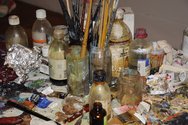
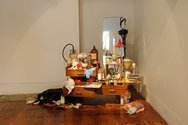
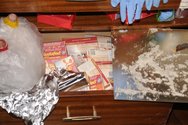
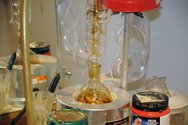
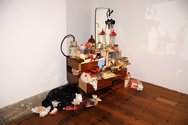
 Two Rooms presents a program of residencies and projects
Two Rooms presents a program of residencies and projects Advertising in this column
Advertising in this column



This Discussion has 0 comments.
Comment
Participate
Register to Participate.
Sign in
Sign in to an existing account.